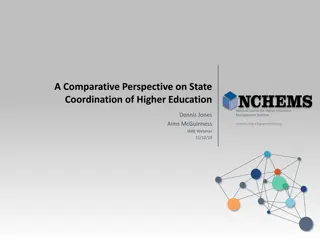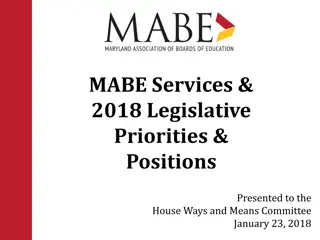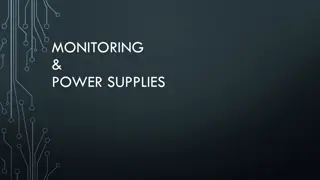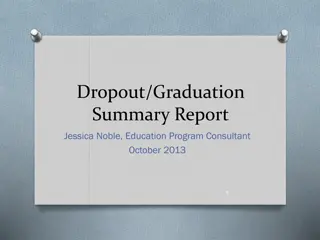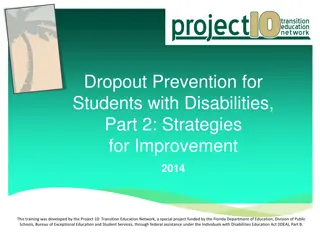Dropout Prevention in Local School Boards
Explore the role of local school boards in preventing dropouts through funding from the U.S. Department of Education. Learn about the reasons students drop out, the impact on economics, challenges faced by rural schools, and steps for improvement. Access online training resources for further information.
Download Presentation

Please find below an Image/Link to download the presentation.
The content on the website is provided AS IS for your information and personal use only. It may not be sold, licensed, or shared on other websites without obtaining consent from the author.If you encounter any issues during the download, it is possible that the publisher has removed the file from their server.
You are allowed to download the files provided on this website for personal or commercial use, subject to the condition that they are used lawfully. All files are the property of their respective owners.
The content on the website is provided AS IS for your information and personal use only. It may not be sold, licensed, or shared on other websites without obtaining consent from the author.
E N D
Presentation Transcript
The Local School Boards Role in Dropout Prevention July 2017 Sandy Addis, EdD Executive Director, National Dropout Prevention Center/Network Sandy Bales, EdD Consultant, National Dropout Prevention Center/Network
The Local School Boards Role in Dropout Prevention was developed through funding provided by the U.S. Department of Education as part of the High School Graduation Initiative Program. The views expressed herein do not necessarily represent the positions or policies of the U.S. Department of Education. No official endorsement by the U.S. Department of Education of any product, commodity, service, or enterprise mentioned in this publication is intended or should be inferred.
Objectives 1. Understand the reasons for dropping out. 2. Understand the economics of dropping out. 3. Understand the challenges of small and/or rural school system dropout prevention (optional see NOTE below). 4. Understand the unique influences exerted by local school boards on graduation rates in rural communities.
Framing Questions 1. Why do students drop out of school? 2. How does dropping out of school affect personal, local, and national economics? 3. What are the unique dropout prevention challenges in small and/or rural school systems? 4. What steps can local school boards take to positively impact the dropout rate in rural communities.
Online Training Resources Education Resource Information Center (ERIC) http://eric.ed.gov High School Graduation Initiative http://www2.ed.gov/programs/droupout/index.html National Dropout Prevention Center http://dropoutprevention.org Office of Juvenile Justice and Delinquency Prevention s (OJJDP s) Model Programs Guide (MPG) http://www.ojjdp.gov/mpg/ What Works Clearinghouse (WWC) http://ies.ed.gov/ncee/wwc/
Framing Question 1: Why do students drop out of school?
Top Five Reasons Students Drop Out of School 1980 1988 2005 (Ekstrom et al., 1986) Didn t like school (33%) (Jordan et al., 1994) Didn t like school (51%) (Bridgeland et al., 2006) Classes were not interesting (47%) Missed too many days and could not catch up (43%) Spent time with people not interested in school (42%) Too much freedom and not enough rules in my life (38%) Was failing in school (35%) Poor grades (33%) Were failing school (44%) Chose to work (19%) Couldn t get along with teachers (34%) Couldn t keep up with school work (31%) Getting married (18%) Feel like they don t belong at school (25%) Couldn t get along with teachers (15%)
Outstanding Responses Poor Grades 1980 1988 2005 (Ekstrom et al., 1986) (Jordan et al., 1994) (Bridgeland et al., 2006) Classes were not interesting (47%) Missed too many days and could not catch up (43%) Spent time with people not interested in school (42%) Didn t like school (33%) Didn t like school (51%) Poor grades (33%) Was failing school (44%) Chose to work (19%) Couldn t get along with teachers (34%) Getting married (18%) Couldn t keep up with school work (31%) Too much freedom and not enough rules in my life (38%) Was failing in school (35%) Feel like they don t belong at school (25%) Couldn t get along with teachers (15%)
Relationship Between Grades and Graduation Four-Year Graduation Rates by Freshman GPA 98 97 100 93 Percentage Who Graduated in Four Years 86 90 80 72 70 60 53 50 40 28 30 20 6 10 1 0 0.0 0.5 1.0 1.5 2.0 2.5 3.0 3.5 4.0 Freshman GPA (Rounded to nearest 0.5)
Outstanding Responses - Absences 1980 1988 2005 (Ekstrom et al., 1986) (Jordan et al., 1994) (Bridgeland et al., 2006) Classes were not interesting (47%) Missed too many days and could not catch up (43%) Spent time with people not interested in school (42%) Too much freedom and not enough rules in my life (38%) Was failing in school (35%) Didn t like school (33%) Didn t like school (51%) Poor grades (33%) Were failing school (44%) Chose to work (19%) Couldn t get along with teachers (34%) Getting married (18%) Couldn t keep up with school work (31%) Feel like they don t belong at school (25%) Couldn t get along with teachers (15%)
Relationship Between Attendance and Graduation Four-Year Graduation Rates by Freshman Absence Rates 100 Percentage Who Graduated in Four Years 87 90 80 70 63 60 50 41 40 30 21 20 9 10 5 2 1 0 0 0-4 5-9 10-14 15-19 20-24 25-29 30-34 35-39 40+ Days Absent per Semester (Course cutting counted as partial days)
Outstanding Responses School Climate 1980 1988 2005 (Ekstrom et al., 1986) (Jordan et al., 1994) (Bridgeland et al., 2006) Classes were not interesting (47%) Missed too many days and could not catch up (43%) Spent time with people not interested in school (42%) Too much freedom and not enough rules in my life (38%) Was failing in school (35%) Didn t like school (33%) Didn t like school (51%) Poor grades (33%) Were failing school (44%) Chose to work (19%) Couldn t get along with teachers (34%) Couldn t keep up with school work (31%) Getting married (18%) Feel like they don t belong at school (25%) Couldn t get along with teachers (15%)
What is School Climate? Does the school feel safe and inviting? Do students and parents feel good about their school? Is there a positive identification with the school? Are the physical surroundings of the school clean, orderly, and appealing? How are parent participation rates at school events? Do parents, teachers, and leaders communicate often? Is there an ongoing focus on graduation as an end goal?
How Does Instruction Impact Graduation Rates? Are courses interesting to students? Do students see relevance in instruction? Are students active learners? Is technology used to make instruction interesting? Are instructional methods and speeds varied for different students? Are numerous career pathways and career-related courses offered?
How Do Teachers Impact Dropout Rates? Are teachers trained in at-risk factors and dropout prevention strategies? Do teachers make students feel valued and welcome? Are all students personally known by teachers? Do teachers initiate positive communications with parents and students? Do early-grade teachers own the dropout problem?
Dropout Factors and Trends Students who drop out often cite factors across multiple domains and there are complex interactions among risk factors. Dropping out of school is often the result of a long process of disengagement that may begin before a child enters school. Dropping out is often described as a process, not an event, with factors building and compounding over time.
Effective Dropout Prevention Involves a Coordinated Effort Family Student Community School
Framing Question #2: How does dropping out of school effect personal, local, and national economics?
Economics of Dropping Out Students who drop out typically: Earn less, Pay less in taxes, and Rely more on public health programs. And are more likely to: Become involved in the criminal justice system and Use welfare services.
Unemployment Rate by Educational Attainment, 2014 Doctoral degree 2.1% Professional degree 1.9% Master s degree . 2.8% Bachelor s degree 3.5% Associate s degree . 4.5% Some college . . 6.0% High school degree . 6.0% Less than a high school degree . 9.0% Source: Bureau of Labor Statistics
The High Cost of Dropping Out Example: The table describes annual Colorado if the graduation rate had been 90% in 2013. annual increases for the state of Quantity Increase with 90% Graduation Rate - 2013 Indicator New Jobs 1,250 Earnings $100 Million State and Local Tax Revenue $4.9 Million Spending $85 Million Home Sales $300 Million Auto Sales $12 Million
Framing Question #3: What are the unique dropout prevention challenges in small and/or rural school systems?
Rural Dropout Prevention Challenges District/School Capacity Slide 1 Fewer management support systems Greater per pupil cost Higher number of teachers teaching outside major specialty at secondary level Less breadth and depth in secondary program (especially in science, math, languages) Less availability of programs for disabled students
Rural Dropout Prevention Challenges District/School Capacity Slide 2 Less availability of telecommunication technology (e.g. bandwidth for Internet) Less fiscal capacity Less specialized space and equipment for science, math, languages Less availability of planning support services Fewer evaluation support services Less expertise to compete for grants
Rural School Prevention Challenges Personnel Capacity Employment of generalists instead of specialists Inadequate time, resources, and/or expertise to develop original materials for school improvement
Rural Dropout Prevention Challenges Local Government Capacity Geographic isolation Low population density Mobility Lack of fiscal resources Lack of expertise and human resources Personal familiarity Resistance to innovation Lack of ancillary services
Framing Question #4: What steps can local school boards take to positively impact the dropout rate in rural communities?
School Board Roles That Influence Graduation Rates Establishing priorities Approving and funding programs Communicating the issue Setting policy and practice Source: Georgia Leadership Associates of King-Cooper and Associates
Establishing Priorities What determines the point at which students are cut off from school? What are the guidelines for rule implementation? How do educators make decisions for wounded and traumatized students? How does the board balance popular perception against best interests of students? How is the use of alternative discipline options determined?
Approving and Funding Programs Do dropout prevention programs and initiatives exist in the system? How are dropout programs selected? Are programs research-based and matched to local needs? Are there opportunities for credit recovery, alternative routes to graduation, and opportunity for school reentry?
Communicating the Issue Do board members understand the dropout issue and the local impact of dropouts? Are board members able to explain dropout and graduation rates? Do board members understand at-risk students and risk factors? Are board members familiar with local rates and local risk factors? Do board members focus community attention on the issue?
Setting Policy and Practice Are programs producing results? Is there local investment in dropout prevention? Are dropout prevention programs first to go in tough budget times? Are there local policies that contribute to students dropping out? Is the graduation rate considered when new policies and initiatives are adopted?
Next Steps Continue to update data and review school/system information routinely. Communicate with school representatives to determine program growth needs. Provide for a developing program.

















